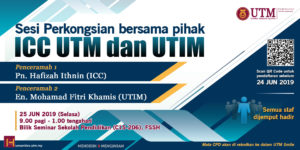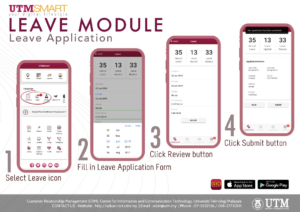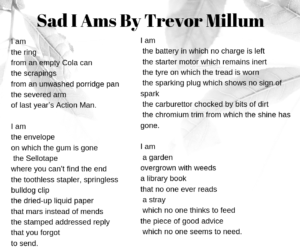
Why do we file for IP protection?
- To protect your IP from others copying, manufacturing, selling or importing your invention without permission
- ELPPT purposes: as bonus (10%).
- Commersialisation purpose.
What can be registered as IP?
- Your research output/findings. For example, if you have a student, you can’t copyright the whole thesis. You only can copyright the output or findings (which is part of the thesis). Meaning, the output is UTM property and thus, as a staff or student, you can copyright your output.
- Your product such as “tudung” design, song lyric etc. that you can file under “patent“. But one product can be copyrighted under patent and also industrial design, like tudung. The design of the tudung itself falls under the industrial design but you declare it as a product that you create, it falls under patent.
- Your notes using OCW (this is not under Innovation and Commersialisation Centre or ICC or InnoComm).
Where to apply a copyright for your product?
Go to this link
But, if you want to skip the process of copyright through ICC or InnoComm, you can use UTIM or do the copyright (pay the fee for RM200) yourself.
UTIM is a UTM company that help you to copyright your work that you wish it to be yours, not UTM if 1) it is not related to your field, 2) you don’t use UTM facilities and 3) you don’t create the product during office hours.
Note: Your password would be the one like UTMFIN (if you forget, email the IT manager UTMFIN to reset your password for you).
Who would be the main contributor?
ONLY ONE can be the main contributor. So, if you have other researchers in your group, please make sure that you negotiate and discuss who would be the main contributor.
Note: You need to put the percentage of the contributors as well especially if it involves monetary thingy. Such as a product that you produce something that you can commercialize then later on you declare to cut certain percentage of those you put as contributors.
Which is which?
a) Patent
Patent is a technical solution. It has to be something new. Need to have inventive steps that not obvious to be copied easily. It has to have industrial applicable.
It is advisable to patent first your work before you publish. Once you publish, it is copyrighted under the publisher. So, technically it is can be used under the copyright of the publisher. That’s why you cannot recycle it again elsewhere.
Things that cannot be patented
i) Discoveries like new species of animals, plants, mathematical and scientific methods
ii) Schemes of doing business
iii) Methods of treatment to save animals or human (kaedah merawat) not medicines (medicines can be patented).
iv) Common name like “Kimono” (this is a common name referring to Japanese traditional clothing). So, when Kim Kardashian wants to make “Kimono” as her patented and trademark, it is not allowed. But for Apple, their trademark is the logo of the apple, not the word “Apple” itself. But when people want to refer to their product, of course they use the word “Apple” but not referring to the fruit, but the gadget/IT product.
b) Utility Innovation
No need inventory steps. You still can file it to be IP.
c) Industrial design
It has to be external design. For example, the inside component of a washing machine, you cannot file it under industrial design. It has limited time frame for 10 years and need renewal.
d) Trademark
You cannot request for a common name like Apple. That is why “Apple” product only IP the logo (picture). There is no duration for renewal and no need to be renewed. Like paracetamol (is a industrial design) and thus it can reproduced by other company other than Panadol (it is a company). You can also file IP for “phrases” like I’m lovin’ it (McD) – under branding etc. but if you can notice it, they make the grammatical error with purpose because if their trademark is the fully grammatically correct phrase, then it would raise the issue of using the phrase for common usage.
e) Trade secret
Like KFC recipe, coca cola recipe etc. You can file for Trade secret (because it won’t be disclosed as compared to patent). Like red velvet cookies (it is your new invention, if you copyright it, it just stops people from reproduce the ingredients but does not stop people from reproducing the product, so better do it under Trade Secret).
f) Copyright (Hakcipta)
It has to be reduced into material forms like written form, audio/sound form etc. It has to be the 1st one copyright in Malaysia. Like Apps, musical work, sound recording, derivative works [(karya terbitan) contohnya kerja-kerja terjemahan] but you need to get permission from the author but is the author has died, you need to wait 50 years after his/her death. Let’s say you want to translate Terman’s books. He passed away in 1950s, so we can translate his work after 50 years of his death without getting any permission as long as his work is not published and patented with the organisation he worked when he copyrighted his work.
It have to be registered under MYIPO.







